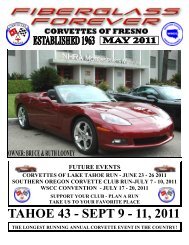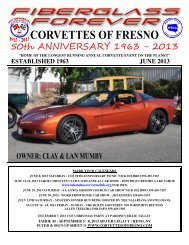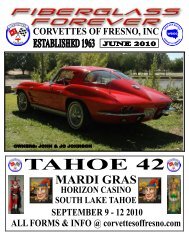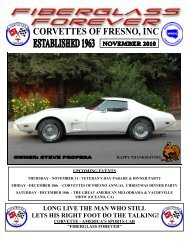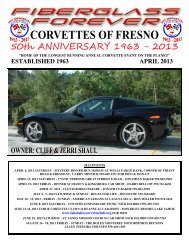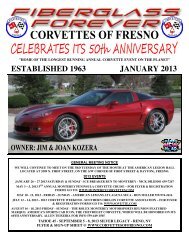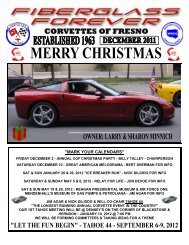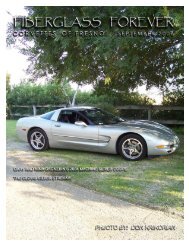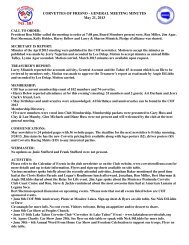Twas the Night Before Christmas - Corvette Style - Description ...
Twas the Night Before Christmas - Corvette Style - Description ...
Twas the Night Before Christmas - Corvette Style - Description ...
Create successful ePaper yourself
Turn your PDF publications into a flip-book with our unique Google optimized e-Paper software.
Sealers and glazes can be used without re-polishing <strong>the</strong> surface and applied over prior<br />
coats of wax. Darker paints respond much more visibly to a sealer/glaze—in most cases lighter<br />
colors and whites don't have as much visual depth and <strong>the</strong> effect of a sealer/glaze is less<br />
noticeable. In some cases, show vehicles are treated to frequent coats of sealer/glaze and see no<br />
wax at all—this approach is fine, and will probably promote a deeper luster than sealer/glaze and<br />
subsequent waxing toge<strong>the</strong>r, but it affords only minimal protection from <strong>the</strong> elements. Wax acts<br />
as <strong>the</strong> hard candy shell of paint treatments, and without it <strong>the</strong> paint isn't as well protected.<br />
The practice of wax application and removal is not complicated but needs to be done<br />
thoroughly and correctly. Consistent surface coverage and thickness leave a shine far superior to<br />
uneven application, insufficient removal or ineffective rubbing. The formula for success is<br />
simple: select a body panel to work on, and apply your wax evenly and lightly, in parallel<br />
movements. Then buff <strong>the</strong> hazed wax with a 100-percent cotton towel or microfiber cloth. Rub<br />
<strong>the</strong> paint until no wax remains. Don't forget to turn <strong>the</strong> towel frequently, and shake it out as well<br />
(downwind and away from <strong>the</strong> car, of course). Be careful to avoid getting wax on plastic and<br />
rubber that can absorb it and become discolored. It's better to leave a little space between <strong>the</strong><br />
paint and <strong>the</strong> suspect plastic/rubber and <strong>the</strong>n touch it up later with careful, small movements of<br />
<strong>the</strong> applicator.<br />
If you're following a complete treatment of polish and sealer & glaze, look for a highquality<br />
carnauba wax with no cleaning agents. You're essentially sealing <strong>the</strong> sealer & glaze, and<br />
adding a protective shield. One good coating should be enough to keep things shiny and bright<br />
for months depending on your local climate and conditions.<br />
If you're working on a light-colored vehicle (white, yellow, beige, silver, etc), a single-step<br />
cleaner wax may be better suited for <strong>the</strong> job. This product is carnauba wax but with minor<br />
polishing agents that break down during application. Carnauba cleaner waxes can take two steps<br />
out of <strong>the</strong> finishing process for lighter-colored paints that don't have as much inherent visual<br />
depth.<br />
After you finish each section of paint remember to go over <strong>the</strong> nooks & crannies and<br />
associated parts and trim items to catch any wax left behind that would o<strong>the</strong>rwise turn into<br />
annoying little bits of white crud. If you overlook <strong>the</strong>se areas until after <strong>the</strong> waxing process is<br />
finished a detailer's pick or soft nylon bristle brush can work well to remove <strong>the</strong> residue.<br />
Quick Detailing: Between washings dust and light road film can be removed without<br />
water. By combining <strong>the</strong> use of a car duster (frequently referred to as <strong>the</strong> California Car Duster)<br />
and a detailing spray, you can keep your ride much cleaner between washings. A regular practice<br />
of "dusting & detailing" can also extend <strong>the</strong> time between washings. A light coating of dust can<br />
be swept away with <strong>the</strong> car duster and chased with a treatment of detailer.<br />
The trick is to know how much dirt is on <strong>the</strong> car and what sort. If <strong>the</strong>re's a thorough layer<br />
of dust, but it's light and not stuck to <strong>the</strong> paint, you can run <strong>the</strong> car duster over your vehicle to<br />
remove all but trace amounts of dirt. Then you hit it with a spray wax or instant detailer to<br />
complete <strong>the</strong> job. In some cases you can't dust off <strong>the</strong> grime—rain has turned atmospheric<br />
residue to a fine mud or <strong>the</strong>re's some sort of muck adhered to <strong>the</strong> paint, such as bird droppings<br />
or tree sap. Some things can only be removed by washing with soap and water.




